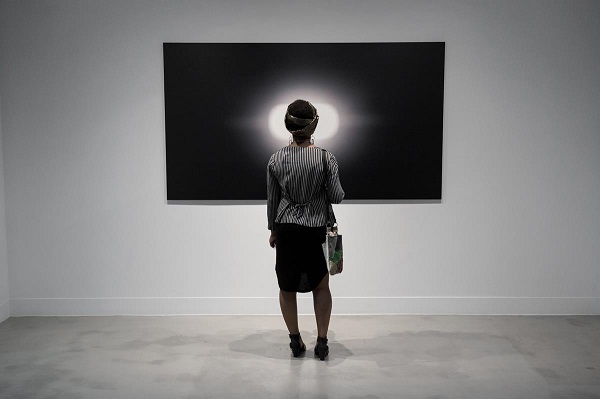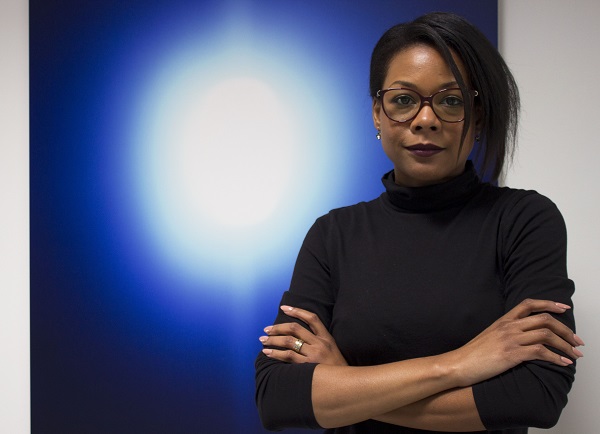There’s a lot of buzz surrounding the word “curator”. Actually, there’s too much buzz. Everything from playlists to sneakers to cell phone cases are presented in “highly curated lists” behind click-worthy headlines. The word’s been thrown around for a while now (at least since 2012), but the phrase wasn’t created in the ping-pong break room of some listicle website or by a content marketing thoughtleader.
“It comes from the Italian root curare, which means to be a custodian or a caretaker,” said Aja Martin, gallery director of Zhulong Gallery in Dallas’ Design District (pictured above). “The word has slipped into common parlance but when people use it they only mean ‘selecting.’ I consider myself a steward of the art that we show.”
Since 2014, Martin has brough a curatorial sensibility to her role as gallery director, focusing on how artists’ works should be presented within context. Klyde Warren Park is her most recent undertaking; she’s been entrusted with the space for Aurora 2015, the public contemporary exhibit that spans the 68-acre Dallas Arts District.
A Colorful Past
Martin’s journey to becoming an esteemed voice in the art world was far from classical — modern at best. After spending an early childhood in South Oak Cliff and then growing up on the southwest side of Houston, Martin wasn’t sure about what she wanted to do with her life. A false start at Texas State University led to moving back home due to financial woes and trying again at University of Houston. When the strain of late-night waitressing and a trying commute proved too much for classwork, efforts were moved to Austin Community College. Then, something clicked for Martin in an art history class.
“That’s when I knew what I loved,” said Martin. “Even though this was three or four years after high school graduation and people were finishing their degrees, I was just finding out what I wanted to do. I got really serious, continued classes at ACC, moved back to U of H and finished my degree in a year and a half. I graduated from high school in 1997 and didn’t get my degree until 2007.”
The last year and a half of that decade was put to good use. Martin reached out for every opportunity available while at U of H, including membership in the Blaffer Student Association, becoming an Honors College fellow and docent at the Blaffer Art Museum, at which she eventually landed a curatorial assistant position. Martin earned a meaningful mentorship with the then director of the Blaffer Gallery, Terrie Sultan.
“She made it known that I couldn’t do what I wanted without a masters degree,” said Martin. “A museum colleague asked if I’d applied to Southern Methodist University, but I hadn’t. An old high school teacher told me I wouldn’t fit in there and discouraged me from applying. She should’ve encouraged me to go and to find support through multicultural resources so that I could make a home there.”
Martin applied to SMU at the last minute and was awarded one of their top fellowships, receiving a substantial stipend and fully covered tuition. A stint at the Dallas Museum of Art took her away from her thesis– a study on The High Line in Manhattan, making her especially perfect for the Aurora curating gig– but she received her Master of Fine Arts in Art History (MFA) in 2011. An MFA traditionally leads to a life of academia, but after teaching, Martin realized she needed to be amongst the people in the museum space and quickly jumped on the Zhulong opportunity.
“As a scholar you can hide in your institution and your books. You don’t have to be out in the world,” said Martin. “I’m seeing this other side of the arts I never knew existed. Going to Art Basel in Miami when Beyoncé and Pharrell are there…it’s just this glamorous side of the art world that I never thought about.”
Connecting The Dots
Wine-colored nails coordinate with thin-rimmed Chloe glasses and a vampy lip as Martin, clad in all black, sits in the center of the gallery. It’s not hard to picture her in the midst of the trendiest of art events, but she’s something of an unfamiliar sight in the mink-lashed, quilted-bagged, bottle-service-at-brunch society of Dallas. She once became disheartened in the city and considered leaving, but instead “dug in” and resolved to stimulate change. Martin’s efforts are most notably seen in her approach to extend art to an audience usually left consuming and creating in the margin.
“Economic strife puts a wedge between people and art. I can see how someone who doesn’t feel they have ownership of these institutions and the art could be intimidated,” said Martin. “We had a party called Soft Power with Darryl Ratcliff and the City of Dallas that was all about cultural equity. For a gallery of this stature to say ‘We care about institutional racism’ is huge.
I see more young people and people of color in this gallery than maybe anywhere; we work really hard to break those barriers down. Every person who walks in this gallery is greeted and given an introduction to the exhibit. Maybe if they can become comfortable with Zhulong, they can become comfortable with other galleries and museums, and traveling to see art.”

Barriers to seeing art pale in comparison to those of pursuing it. Unpaid, 30-hour workweek internships are standard, as is chasing freelance work in the form of small gallery exhibits and poorly paying writing opportunities. These factors led Martin’s father to find her path “a bit ridiculous,” wondering how financial stability could ever result from a career in the arts.
Perhaps it’s the sheer improbability of it all that fuels Martin to work 70 hours a week: planning events, curating exhibits and constantly discovering and engaging artists. All of this, with the significant help of the gallery assistant and “backbone,” Maribel Morales.
A Lighted Path
The stillness of a freshly hung show followed by the gratifying drive home after an opening are the feelings Martin most appreciates. Feelings of being snubbed amongst her peers however, are the least enjoyable.
“I can get the cold shoulder but I can ignore it,” said Martin. “I’ve dedicated my life to the arts; you can’t tell me I don’t belong in certain art spaces. I feel like women have a perfectionism problem, ‘If I haven’t mastered something then I don’t have the right to be assertive about what I think.’ Men aren’t like that.”
Zhulong translates literally from Chinese to mean “torch dragon” or “illuminating darkness.” “Openness and inclusivity,” said Martin when asked about her hope for the future of Dallas art.
The light is not lost on Aja Martin.
Aja Martin images credit Kenyatta Giddings. First image: Aja Martin in front of Erika Blumenfeld’s “Midnight Twilight” as part of the Light of the Midnight Sun exhibit. Second image: Aja Martin in front of Erika Blumenfeld’s “Easterly Light” as part of the Light of the Midnight Sun exhibit. Zhulong Gallery images credit the Zhulong Gallery’s Facebook page.






